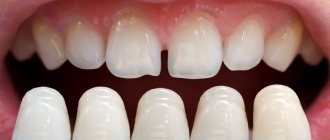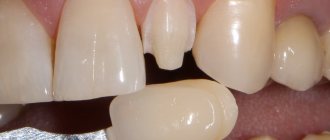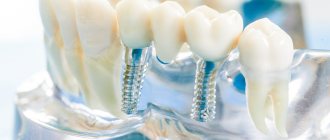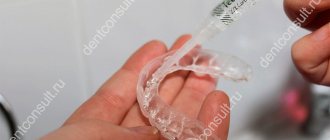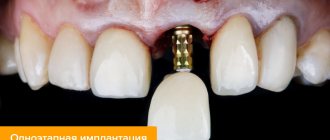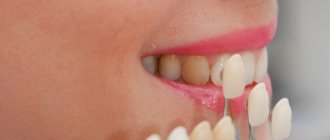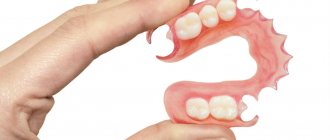For prosthetics, dentists use different materials from plastic to metal. The doctor selects the appropriate option taking into account many factors: practicality, aesthetics, price, strength, durability, reliability. Clients of Dr. Granov's clinic prefer E-max veneers and inlays.
E-max is a strong ceramic material that has many advantages. Here are just the main ones:
- durability: veneers and inlays made from this material can last for decades;
- oxidation resistance;
- natural look: you can choose a shade that exactly matches the color of your teeth;
- biocompatibility: E-max does not cause allergic reactions and is not rejected by the body;
- Hygienic: the material does not become covered with plaque and is easy to clean.
E-max is widely used in dentistry. This is a good material for crowns and half-crowns. E-max is also suitable for forming inlays. Ceramic overlays on teeth - veneers - are also often made from it.
How does an inlay differ from a filling?
The filling is made of a plastic material that hardens and takes the desired shape. It is made and installed right in the dentist's office in one appointment. However, a filling will not help when the tooth is severely damaged. In this case, you will need a ceramic inlay. It is made in the laboratory using an individual impression. It not only closes the resulting cavity, but also exactly repeats the shape of the destroyed area of the crown.
Advantages over fillings:
- Higher efficiency
. It is possible to restore a severely damaged tooth. A filling is suitable only if the cavity occupies less than a quarter of the crown, and an inlay can restore from 25 to 60%; - Naturalness
. The inlay imitates the anatomical shape of the chewing surface. It is almost invisible, while the filling can be seen; - Higher strength
. Microprostheses do not develop cracks. A filling of this size would quickly crumble, so it is not suitable for restoring extensive damage; - Durability
. The tab will last 5–7 years. At the same time, it will remain unchanged and will not lose its original characteristics; - Ensuring the prevention of secondary caries
. Sometimes the filling can become infected again. The insert fits very tightly and does not shrink over time, so this risk is eliminated; - Color fastness
. The fillings have a porous structure, so they are easily stained by tea, coffee, and tobacco. Ceramics are not subject to color changes.
Flaws:
- They cost more;
- They take longer to produce. The filling can be placed in one visit to the dentist. And to install the tab, you will need 2 visits with a break for the manufacture of a microprosthesis in the laboratory.
Composite or temporary veneers: what's the difference?
Patients often confuse composite restoration with the creation of temporary veneers using the direct method. At the same time, the similarity is only in the technological approach - both of them are formed directly in the patient’s oral cavity. But the tasks, materials, and even the professional approach differ significantly in each specific case.
Composite onlays are a permanent solution that allows you to restore aesthetic perfection to your teeth for several years. When working, the doctor uses a special composite composition and manually creates the shape of each tooth in the patient’s mouth. The finished result has good strength, reliability and looks good in the mouth. Microprostheses replace teeth both externally and functionally - the patient can safely eat different foods and drinks, smile and talk.
Direct installation of temporary veneers is carried out using different algorithms. The dentist takes an impression of the patient’s teeth before preparing the enamel, which allows the original shape of the teeth to be preserved. After grinding the incisors for veneers, the doctor makes a repeat impression for the dental laboratory. Based on it, permanent onlays will be made from the material chosen by the patient - ceramics, zirconium dioxide, porcelain.
To make a temporary smile, the dentist uses the first impression, which is filled with a polymer composition of a suitable shade. After this, the impression is fixed on the patient’s jaw and left until completely hardened. After polishing, temporary veneers look like real teeth, but are less durable and more susceptible to external conditions.
Indications
The main use case is the treatment of caries. A ceramic inlay for a tooth is needed if its crown is destroyed by 25–60%. If the cavity occupies less than a quarter of the surface, then you can get by with a filling, but if more than 60%, then a crown is needed. Other indications for installation:
- Destruction of non-carious origin;
- The need to install a bridge prosthesis (microprostheses are placed on abutment teeth to increase their strength);
- Increased abrasion of enamel.
Service life and care
The service life of composite microprostheses is several years; ceramic and “dioxide” ones can reach 10 years. Products made by milling on a robotic machine have maximum accuracy and fit to the tooth, so they last longer than usual. First of all, the service life depends on the health of the teeth, since if caries occurs deep in the cavity, it will be necessary to remove the old “onlay”, treat the tooth and install a new one or (more likely) a crown. To extend the life of dental inlays, do not forget about simple hygiene procedures and regular visits to the dentist - during routine preventive examinations, he will be able to detect damage to the denture, since bacteria and microbes can penetrate under it through cracks and cracks.
Contraindications
This type of microprosthesis cannot be installed in the following cases:
- bruxism (grinding teeth in sleep);
- steep slopes of hillocks;
- rapidly progressing caries;
- deep cavity extending into dentin;
- inability to ensure complete dryness of the field.
A relative contraindication is poor oral hygiene. In what cases is it not advisable to use:
- A cavity less than 1.5 mm deep (you can get by with a filling);
- The damage has affected the cervical area of the tooth (the inlay will no longer help);
- The tooth is more than 60% destroyed (a crown is required);
- Milk tooth. It makes no sense to restore it using an inlay, since the life of the tooth is less than the durability of the microprosthesis. In addition, a vlkadka costs much more than a filling. Spending so much money to restore a tooth that will soon fall out is not advisable.
How to care for temporary veneers
Fragility is the main problem of short-term wear products. That is why dentists always specify rules of care and nutritional recommendations. Among them:
- refusal of hard and hard foods - nuts, apples, seeds;
- restrictions on the consumption of excessively hot and cold foods;
- using a toothbrush with soft bristles and toothpaste without whitening particles;
- rinsing the mouth with an antibacterial composition after each meal;
- reduction in vigorous activity – traumatic sports;
- use of a mouth guard if you have a diagnosis of bruxism.
Although plastic covers are only worn for a short period of time, proper care is a must. If the polymer breaks down or cracks during wear, the teeth underneath will suffer, which will lengthen the time of aesthetic restoration.
The quality of temporary and permanent veneers directly depends on the professionalism of the doctor and the capabilities of the dental clinic. This is why choosing a dentist is always very important. The beauty of teeth, the comfort and confidence of the patient depend on the doctor’s work. When choosing a dentist and a medical center, the 1dentist portal suggests focusing on independent ratings, the creation of which takes into account all patient reviews.
Types of tabs
Depending on the material of manufacture, they come in the following types:
- metal-ceramic
- the most budget-friendly; - ceramic
– the most aesthetic; - made of zirconium dioxide
- the most durable.
These microprostheses are also classified depending on their position in the tooth. According to this criterion, the following varieties are distinguished:
- Inlay
– the hole in the tooth is box-shaped, the inlay is installed inside it; - Onlay
– the overlay has an external side; - Overlay
– only one wall is preserved, the overlay replaces almost the entire crown; - Pinlay
– the inlay has additional cavities or pin inclusions for better fixation.
The type of inlay based on its position in the tooth is selected by the dentist after an initial consultation.
Price of dental veneers
The price of the service in our dentistry is determined by the choice of the type/quantity of veneers, the method of prosthetics, the state of health of the oral cavity, the cost of diagnostics, therapeutic treatment, anesthesia, and the doctor’s qualifications.
The most budget option is dental onlays made of composite (5-6 thousand rubles), orthopedic porcelain structures and lumineers will cost more - 20 and 50 thousand rubles.
| Code no. | Name of procedures | Unit of measurement | Cost, rub. |
| 703 | Taking a two-layer A-silicone impression | 2 000,00 | |
| 704 | Removing a two-layer polyester print | 3 000,00 | |
| 705 | Making silicone keys using a wax model | 3 000,00 | |
| 708 | Wax modeling | 1 500,00 | |
| 713 | Fixation of restoration with dual-curing cement | 2 500,00 | |
| 718 | Temporary composite laboratory crown | 4 500,00 | |
| 808 | Inlay/Onlay/Vener (E-max) | 19 000,00 |
* The prices indicated on the website are not a public offer. The exact cost of treatment can only be determined at an appointment with a doctor.
Prices for treatment in Moscow full price list
Share on social media networks:
Article Expert:
Razumenko Evgeniy Gennadievich
Chief physician and founder of the dental clinic. He has been working in aesthetic dentistry for many years, restoring teeth of any complexity with ceramic and composite restorations. Winner of competitions in aesthetic dentistry. Applies CAD/CAM technologies in prosthetics.
Work experience 22 years
The process of manufacturing and installing inlays on a tooth
Dental prosthetics is performed in several stages:
- Initial consultation
. The doctor assesses the extent of destruction and draws up a recovery plan; - Hygienic teeth cleaning
if necessary; - Selection of the required shade
to match the enamel color; - Removal of tissues affected by caries
, if the destruction was caused by this disease; - Taking an individual impression
, according to which a microprosthesis will be made; - Closing the cavity with temporary material
for the waiting period; - Making an inlay
based on an individual impression in a dental laboratory; - Installation
of the inlay and its fixation using special dental cement.
Thus, a tooth can be restored in 2 visits to the clinic. The first visit is a consultation, treatment of caries and taking an impression, the second is the actual installation.
Removable temporary veneers: what is the danger of universal caps
Overhead temporary veneers for teeth are called finished products that are actively sold on various Internet sites. Their specialty is versatility. According to manufacturers, onlays are suitable for any type of bite and can quickly restore the beauty of a smile without grinding down tooth enamel.
The advertisement promises: for ideal dental aesthetics, it is enough to buy plastic veneers, adjust the size of the crowns by heating them in hot water and instantly try them on, and fix them on the teeth. Problems with finished products begin very quickly:
- Doesn't stick well to teeth. When heated and first tried on, the plastic fits tightly around the teeth, but then it begins to constantly fall out - during a conversation or even just like that.
- Allergic reaction. The polymer used in the production of removable veneers often turns out to be toxic - it provokes allergies, stomatitis and other problems.
- They don't look good in the mouth. Each person has unique bite characteristics, which the dentist takes into account when making composite or ceramic onlays. Universal products are made for a standard ideal bite and rarely have a natural appearance.
- Inconvenient to wear. Since the products do not take into account the structure of the oral cavity, they are often uncomfortable. In addition, they need to be constantly removed before eating, which is why they quickly lose their shape and aesthetics.
If we consider temporary veneers from the dentist’s perspective, then we will talk about special removable onlays. The products are modeled based on the patient’s casts and placed during the production of permanent plates - ceramic, zirconium, porcelain.
Pros of ceramic inlays
A ceramic tooth inlay has many advantages:
- High strength
. An inlay, unlike a filling, significantly strengthens the tooth. Therefore, it is the preferred option if the tooth in which it is installed will be used as a support for a bridge; - Good aesthetic properties
. Ceramics are translucent, so they successfully imitate the natural color of the tooth. It also exactly follows the normal shape of his crown; - The ability to fully restore the chewing surface
. The inlay completely follows the anatomical shape of the tooth. This provides convenience when eating; - Hygiene
. Glaze is applied to the tab as a finishing layer. It creates a glossy surface on which plaque does not accumulate; - Resistance to external factors
. Ceramics does not darken over time, does not change color due to smoking or drinking coloring drinks; - Durability
. A ceramic inlay will last longer than a filling – 5–7 years. There are also more durable inlays, for example, made of zirconium dioxide, but ceramic ones are more aesthetically pleasing compared to them; - No risk of secondary caries
. Inlays, unlike fillings, do not shrink and adhere tightly to the tissue. This eliminates the possibility of cracks and the development of secondary carious lesions; - Easy replacement
. When installing a new inlay after its service life has expired, there is no need to grind the tooth again. Caries does not develop under a microprosthesis of this type, so there is no need to remove the affected tissue. - Bioinertness
. Ceramics does not absorb or accumulate any odors. There is no plaque deposited on it; - Hypoallergenic
. Microprostheses made of pure ceramics do not cause any immune reactions; - No need for special care
. Regular hygiene rules are sufficient.
Will temporary veneers replace permanent ones?
Plastic veneers are temporary overlays. They differ from permanent ones both in appearance and in general characteristics. It will not be possible to replace one with another. Temporary plates are:
- Matte, rough plastic that slowly turns yellow over time. The polymer can simulate a permanent bite, but only for a short time.
- Low strength. The service life of temporary prostheses is 1-3 weeks, but some break even earlier. Wearing plastic veneers instead of permanent ones means constantly monitoring the density of food and protecting yourself from any external influences.
- Moderate aesthetics. When creating permanent ceramic veneers, the dental technician takes into account all aspects of an ideal bite and mathematically calculates the ratio and size of the dental veneers. Plastic caps are less perfect and more like artificial teeth.
